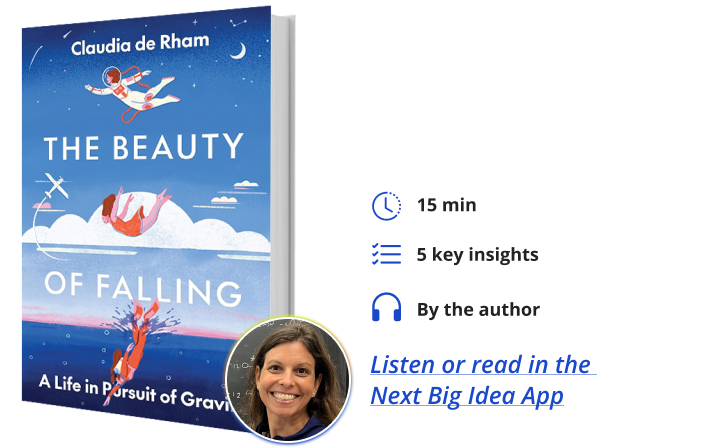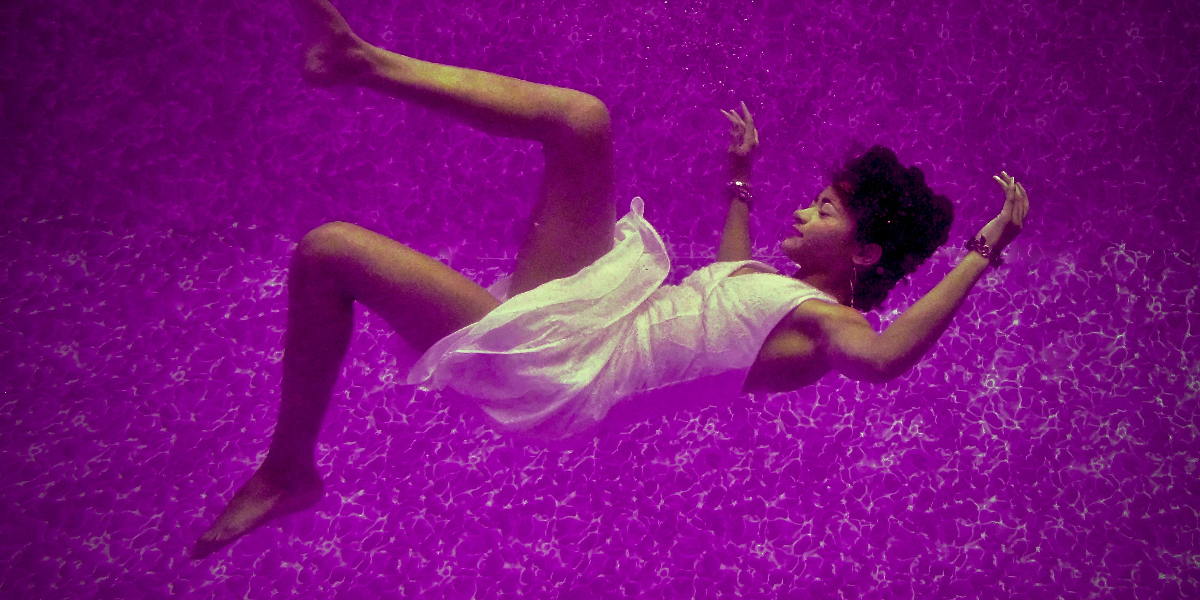Claudia de Rham is professor of theoretical physics at Imperial College London and a member of the American Academy of Arts and Sciences. The recipient of numerous prizes and awards, she is ranked among the most influential researchers in fundamental physics of the past decade.
Below, Claudia shares five key insights from her new book, The Beauty of Falling: A Life in Pursuit of Gravity. Listen to the audio version—read by Claudia herself—in the Next Big Idea App.

1. Universality.
We are all scientists at heart: recognizing patterns, deciphering their meanings, and predicting outcomes in ways that transcend any form of communication. Recognizing these simple patterns and how they structure our world took me from modeling the sadly inexplicable actions of terrorist organizations to slowly awakening an awe for the unknown, introducing me to the thrill of discovering more about the mysteries of our universe.
Throughout this journey, I have always been eager to connect with a more reliable, universal language—to make sense of the world in a way that obviates words and misunderstandings. Gravity (being the most universal phenomenon that exists) was a natural attraction from the start.
Everyone feels and experiences gravity in the same way, independently of who or what you are and look like. You can be a speck of dust, a bacterium, or an elephant, and you will still feel the gravitational pull of Earth. You can never shield yourself from gravity. It connects everything to everyone, everywhere, all the time. It is universal in every sense of the term.
2. Gravity represents the thread that connects us all together.
Thanks to Einstein’s theory of General Relativity, we understand that the sun and planets curve the structure of spacetime around themselves. We are all experiencing this curvature, and that’s how we feel gravitational attraction. Throughout the universe, all elements are connected through gravity and this structure of spacetime.
In fact, we can never really experience gravity at any one point; the experience relies on connecting different points together. If we compare, for instance, the curvature of spacetime with the curvature of the surface of the Earth, it looks like the land and horizon around us are on a flat surface. The first humans to realize this, after hundreds of thousands of years, were the ancient Greeks. They realized that the surface of the Earth is curved when they compared how light rays from the sun hit the ground in different cities.
To really understand gravity, we need to connect different points in space and time with one another. This experience has always been very tangible for me personally because throughout my life, I have been moving from one place to another, conscious every time of how to connect between these different points. Moving from Switzerland to Peru, to Madagascar, to France, to Indonesia, to the UK, to Canada, to the U.S., and now back in the UK.
“To really understand gravity, we need to connect different points in space and time with one another.”
Every time, as a I left behind everything and everyone that had made me who I was thus far, it became clear that our entire existence is nothing more than a patchwork of events in space and time, and it is up to all of us to bridge between them.
There is no such thing as a twisted life path in a straightforward world. Rather, we all follow a straight path through our lives, constantly adapting to the curved reality of the world in which we find ourselves. Just like it is the unique way that we connect various events together that makes our path so special and precious, it is in the thread that connects the patchwork of regions of space and time together that gravity manifests itself.
3. Predicting our own fall.
Gravity’s ability to predict its own fall is inspirational. I have spent more than 20 years attempting to engineer my path with one aim: becoming an astronaut. I persevered every step of the way, only to see my dreams finally disappear within a fraction of a second. I feel a very strong bond with our current description of gravity and its ability to embrace its own failure.
Would I still have trained for years and undergone all those tests if I had known from the beginning that I was fated to fail? I’d like to think so. Facing failure is an essential part of the human experience, one that made me stronger and prepared me for a life of scientific research, where facing failure is an integral part of scientific progress.
More than a century has passed since Einstein’s breakthroughs, and general relativity stands stronger than ever. Gravity has been exhaustively tested, including in some of the most extreme environments, and the evidence unfailingly accords with Einstein’s predictions. At the same time, we have also learned much more about the quantum nature of our world through atomic, nuclear, and particle physics. With these advances, new ideas and theories constantly bubble up in our effort to make sense of the world.
And yet, to date, none has overcome Einstein’s theory of general relativity, despite the obvious need for new physics. For there is one thing that, from the very beginning, general relativity itself has been forthright about: there is a point where the theory must fail, where a brand-new layer of physics waits to be unveiled. From this failure comes the opportunity to probe and appreciate nature on an even deeper level.
The beauty of gravity is intermingled with the beauty of falling. Daring to fail means appreciating each fall not as an embarrassing epilogue but as an opportunity for a more fundamental understanding of nature.
4. Gravity’s well-hidden sense of humor.
It is no coincidence that the word “gravity” is often associated with the idea of being profoundly serious. At the scales with which we are familiar, gravity is the most serious of phenomena, overpowering everyone and everything with the same importance, attention, and dedication. But what if, deep down, gravity was not so solemnly serious? Could it have developed a hidden sense of humor throughout its tens of billions of years of existence? And, after experiencing its own fall, could gravity have developed a healthy sense of its own limits? What if gravity, appreciating that the time has come, could simply let go?
“Gravity is the most serious of phenomena, overpowering everyone and everything with the same importance, attention, and dedication.”
This seemingly innocent question could potentially tackle one of the most challenging questions of physics: reconciling the quantum energy of all particles known to exist with their gravitational effect over the ages of the Universe. In fact, this possibility is so natural that it has been explored time after time over the past century, but each time, it appeared too challenging to make it work. That is until we (my colleagues Gregory Gabadadze, Andrew Tolley, and myself) finally found a way a few years ago. The technical details are best left for the scientific literature, but I explain the gist of it in non-technical terms in the last chapters of The Beauty of Falling.
Whether it will solve all the problems we have is unknown, but our work has been considered one of the most impactful discoveries of physics in the past decade. To paraphrase Feynman, we know we’ve succeeded when we’re finally faced with a question we cannot answer, rather than an answer we couldn’t question. Humanity has been hunting for a tangible understanding of our universe for millennia. As if to humor us, a new possibility has emerged, potentially bringing us a step closer to understanding the story of our universe’s origin and its fate.
5. Gravity is the most significant yet weakest force.
You may have heard that gravity is not a force; rather, it is the manifestation of the curvature of spacetime. While this geometric description is correct and useful, deep down, gravity is still a force, a quantum one, propagating via a fundamental particle that we call the graviton. The real force of gravity manifests itself through the stretching and squeezing of spacetime as gravitational waves pass by.
If you were ever to feel gravity directly, tearing directly through your eardrums or squeezing through your skin cells, it would mean that you are on the edge of a cataclysmic gravitational event, and sadly, this would be the very last thing you ever experience.
Luckily, here on Earth, the effect of gravitational waves passing by is so small that it took a century to build instruments powerful enough to detect them. Through the most precise instrument ever engineered to date, what was detected was not a single graviton but rather the passing of a coherent state of 10 thousand billion billion billion billion gravitons.
The effect of a single graviton would not only be weak and challenging to observe, but it would also be below Heisenberg’s uncertainty principle and impossible even to consider. Yet, joining forces in the most sensational team bonding exercise that one can imagine, these 10 thousand billion billion billion billion gravitons squeezed and stretched together in harmony the space between two mirrors in the LIGO interferometers located several miles apart by a distance smaller than the size of a proton. For the lapse of a few seconds, this was just enough to signal their existence before they continued their unaltered journey towards the other end of the universe.
We’ll never see or feel or hear a single graviton directly, but what fascinates me the most about it is that it instantiates how the most subtle and delicate element of the universe can end up being the most important ingredient in the whole universe: setting space and time alive, dictating the evolution of the universe and creation of the galaxies, forming our home and determining the fate of every living thing in our universe.
To listen to the audio version read by author Claudia de Rham, download the Next Big Idea App today:































